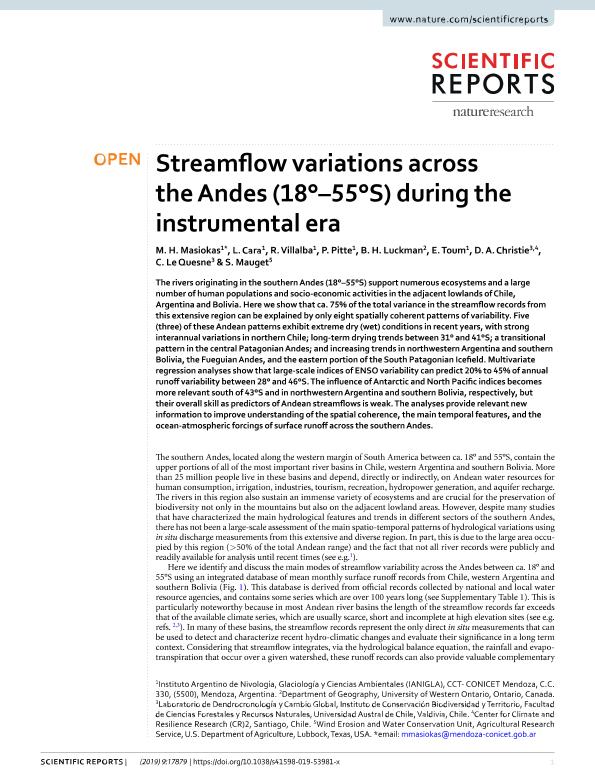Artículo
Streamflow variations across the Andes (18°–55°S) during the instrumental era
Masiokas, Mariano Hugo ; Cara Ramirez, Leandro Javier
; Cara Ramirez, Leandro Javier ; Villalba, Ricardo
; Villalba, Ricardo ; Pitte, Pedro Miguel
; Pitte, Pedro Miguel ; Luckman, B. H.; Toum, Jorge Ezequiel
; Luckman, B. H.; Toum, Jorge Ezequiel ; Christie, D. A.; Le Quesne, C.; Mauget, S.
; Christie, D. A.; Le Quesne, C.; Mauget, S.
 ; Cara Ramirez, Leandro Javier
; Cara Ramirez, Leandro Javier ; Villalba, Ricardo
; Villalba, Ricardo ; Pitte, Pedro Miguel
; Pitte, Pedro Miguel ; Luckman, B. H.; Toum, Jorge Ezequiel
; Luckman, B. H.; Toum, Jorge Ezequiel ; Christie, D. A.; Le Quesne, C.; Mauget, S.
; Christie, D. A.; Le Quesne, C.; Mauget, S.
Fecha de publicación:
12/2019
Editorial:
Nature Publishing Group
Revista:
Scientific Reports
e-ISSN:
2045-2322
Idioma:
Inglés
Tipo de recurso:
Artículo publicado
Clasificación temática:
Resumen
The rivers originating in the southern Andes (18°–55°S) support numerous ecosystems and a large number of human populations and socio-economic activities in the adjacent lowlands of Chile, Argentina and Bolivia. Here we show that ca. 75% of the total variance in the streamflow records from this extensive region can be explained by only eight spatially coherent patterns of variability. Five (three) of these Andean patterns exhibit extreme dry (wet) conditions in recent years, with strong interannual variations in northern Chile; long-term drying trends between 31° and 41°S; a transitional pattern in the central Patagonian Andes; and increasing trends in northwestern Argentina and southern Bolivia, the Fueguian Andes, and the eastern portion of the South Patagonian Icefield. Multivariate regression analyses show that large-scale indices of ENSO variability can predict 20% to 45% of annual runoff variability between 28° and 46°S. The influence of Antarctic and North Pacific indices becomes more relevant south of 43°S and in northwestern Argentina and southern Bolivia, respectively, but their overall skill as predictors of Andean streamflows is weak. The analyses provide relevant new information to improve understanding of the spatial coherence, the main temporal features, and the ocean-atmospheric forcings of surface runoff across the southern Andes.
Palabras clave:
STREAMFLOW
,
VARIATIONS
,
ANDES
,
INSTRUMENTAL ERA
Archivos asociados
Licencia
Identificadores
Colecciones
Articulos(IANIGLA)
Articulos de INST. ARG. DE NIVOLOGIA, GLACIOLOGIA Y CS. AMBIENT
Articulos de INST. ARG. DE NIVOLOGIA, GLACIOLOGIA Y CS. AMBIENT
Citación
Masiokas, Mariano Hugo; Cara Ramirez, Leandro Javier; Villalba, Ricardo; Pitte, Pedro Miguel; Luckman, B. H.; et al.; Streamflow variations across the Andes (18°–55°S) during the instrumental era; Nature Publishing Group; Scientific Reports; 9; 1; 12-2019; 1-13
Compartir
Altmétricas



